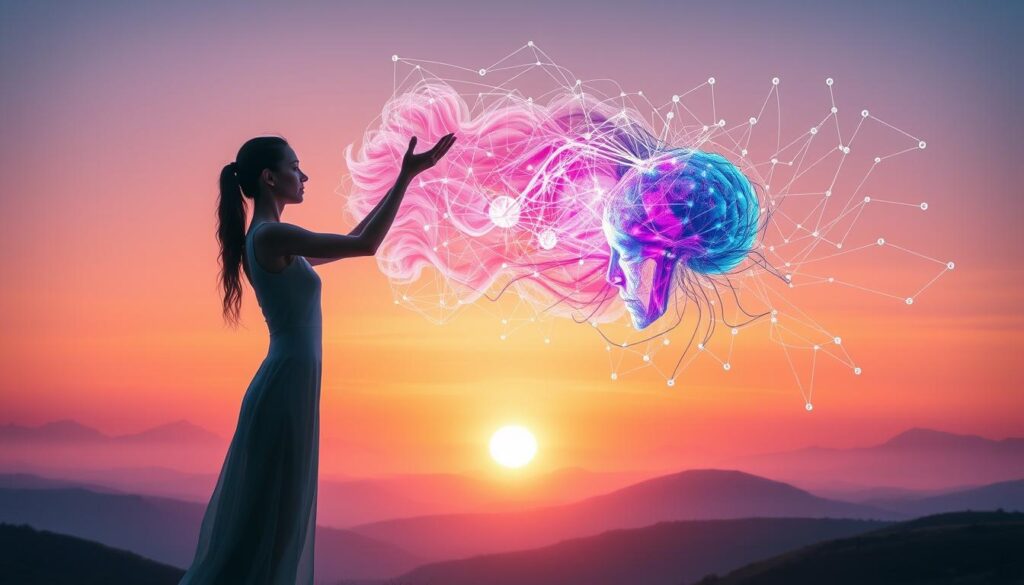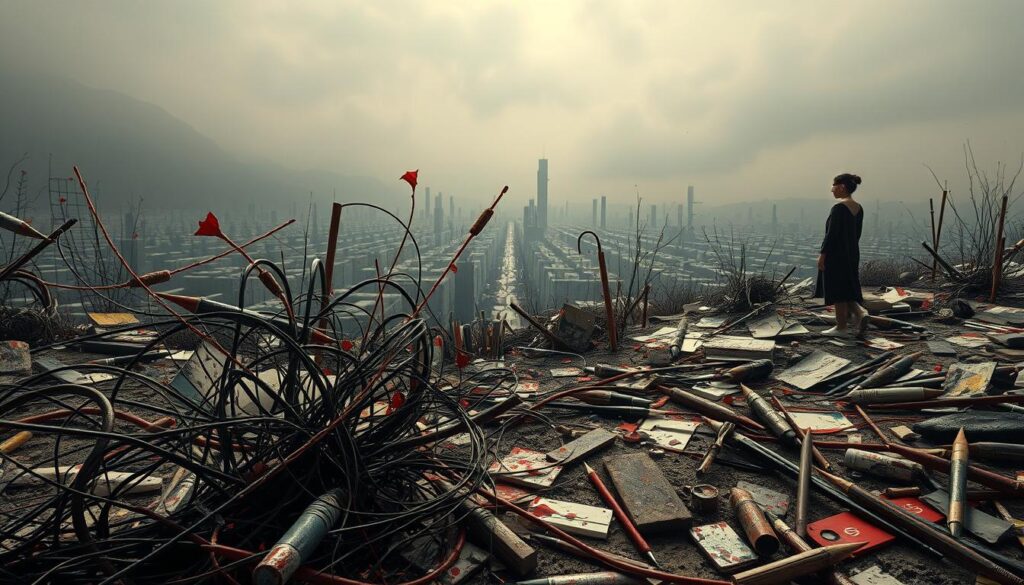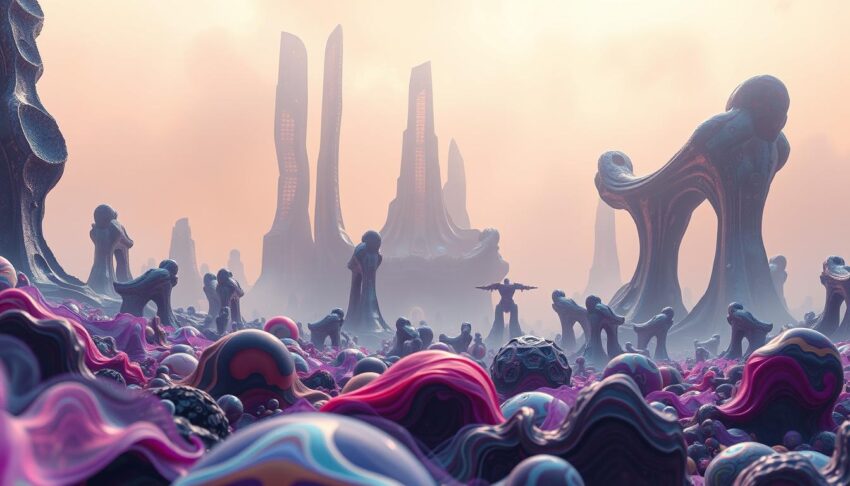The world of AI-Generated Art and Design is very interesting. It mixes technology and creativity in a new way. Artists, designers, and tech fans are all excited about it.
Artificial intelligence design tools are getting better. This changes how we make and see art. We can learn how algorithms, using big data and smart methods, change art-making.
We will show you the cool things that happen when humans and AI work together. This makes art grow and change in exciting ways. Let's explore how AI art is a big deal and a new chance for people to express themselves.
Key Takeaways
- AI-generated art uses algorithms that learn from lots of data. This includes many artistic styles.
- Generative Adversarial Networks (GANs) make art more creative. They work by having creators and critics talk to each other.
- AI is good at copying styles but making new art is hard for it.
- Tools like Artbreeder and DALL-E show what AI can do. They make different kinds of art.
- Choosing the right data for AI is important. It helps avoid biases in AI art.
- AI art will get more real and try new things in the future.
- AI might work with artists in many fields, like building and design.
Understanding AI-Generated Art and Design
AI-generated art and design mix tech and creativity. It uses smart algorithms that learn from lots of data. This data includes many artistic styles and genres.
These systems make unique art, changing how we think about who creates it. Generative Adversarial Networks (GANs) are key in AI art. They have a generator and a discriminator.
The generator makes new art, and the discriminator checks if it's real. This back-and-forth helps AI get better at making art. Variational Autoencoders (VAEs) add more by making art more varied.
“Unsupervised” by Refik Anadol shows AI and art coming together. Anadol's model was trained on MoMA's data. It creates immersive art that blends tech and creativity.
But, AI art doesn't have the same depth or feeling as human art. This makes it less meaningful to us. Also, AI art can have biases if the data it's trained on is not fair.
Tools like Artbreeder and DALL-E help make AI art better. They add new features to AI's art-making abilities. As they get better, AI art will become more lifelike and exciting.
AI and humans can work together to make new art. This mix of skills leads to innovative art. For example, ‘Edmond de Belamy' sold for $432,500 at Christie's in New York.
How Does Artificial Intelligence Create Art?
AI art uses creative algorithms to look at lots of art. It starts with Generative Adversarial Networks (GANs). The generator makes new art, and the discriminator checks it. This makes the art better over time.
Variational Autoencoders (VAEs) also play a big role. They make art in a way that's different each time. This makes the art more interesting. Humans and AI working together can make new kinds of art.
Projects like Unsupervised by Refik Anadol show how AI art works. They use data from places like the Museum of Modern Art. This data makes the art special and meaningful.
But AI can't always make new art. It's good at copying styles but not at being truly new. Tools like Artbreeder and DALL-E can make many kinds of art. Yet, AI art doesn't feel the same as art made by people.
AI is getting better at making art. It might work with humans in the future. This makes us think about what makes art special. Each AI algorithm makes us wonder about originality and human creativity.
The Evolution of AI in Art
The evolution of AI in art has changed a lot. It started as tools for artists. Now, AI can make art on its own.
At first, AI helped artists. It made their work better. Then, AI became smart enough to make art by itself.
One big change was algorithmic artistry. Generative Adversarial Networks (GANs) changed art. They make new images and check if they're good.
GANs and Variational Autoencoders (VAEs) made art more interesting. They let machines try new things. This made art more diverse and creative.
Projects like Refik Anadol's “Unsupervised” show AI's power. It uses data from places like the Museum of Modern Art. This makes art that challenges what we think about creativity.
| Year | Milestone | Details |
|---|---|---|
| 1956 | Introduction of AI | The term “artificial intelligence” was coined during the Dartmouth Summer Research Project. |
| 2014 | Development of GANs | Generative Adversarial Networks allowed for the creation of new images through dual neural networks. |
| 2018 | First AI Artwork Auctioned | “Portrait of Edmond de Belamy” was sold at Christie’s for $432,500, marking a landmark moment in AI art. |
| 2021 | DALL-E Release | OpenAI introduced DALL-E 1, a model capable of generating images from text prompts. |
| 2023 | Emergence of Diffusion Models | Diffusion models began surpassing GANs in quality for image generation. |
The quality of AI art depends on its training data. Bad data can limit AI's creativity. But, humans can help AI by guiding it. This makes art together, changing what we think about creativity.
The Artistic Collaboration: Human-AI Synergy
The bond between human artists and AI is very interesting. It shows how AI art collaboration can make art better. Artists now use AI-powered creative tools to explore new ideas. By 2023, AI art made up about 20% of digital art.
Studies say 75% of artists use AI to improve their work. This shows how well humans and tech work together. AI helps designers, making 60% of them happier with their work.
Interactive art has grown a lot, thanks to AI. In the last two years, AI use in art went up by 40%. This makes art more personal and fun for everyone. Also, 90% of artists like working with AI, saying it helps their ideas.
AI has made art more creative. It mixes old and new styles in new ways. Tools like Generative Adversarial Networks (GANs) and Variational Autoencoders (VAEs) help artists try new things.

Working with AI has many benefits. 85% of designers say AI saves them time. AI also helps them keep up with trends. As AI use grows, so will the art world, blending human touch with tech.
AI-Generated Art and Design in Practice
AI-generated art is changing the world of creativity. It mixes technology with art in new ways. Artists can now make digital art in amazing ways thanks to these tools.
Key Tools for AI Art Creation
Many tools help make AI-generated art. Each tool has special features. They let artists use AI in their work.
| Tool | Primary Function | Key Features |
|---|---|---|
| Artbreeder | Image generation and modification | Collage-based art, blending multiple images, variations of art styles. |
| RunwayML | Real-time video and image editing | Integration with creative software, customizable models, collaboration features. |
| DALL-E (OpenAI) | Text to image generation | High-quality image generation based on textual prompts. |
| NVIDIA GauGAN | Image synthesis | Transforming sketches into photorealistic images, intuitive interface. |
| Midjourney | Creative image generation | Supports unique art styles, community-driven feedback on creations. |
Popular AI Design Applications
Many AI design apps are popular with artists. They help make digital art and let artists work together. Artists say these tools make their work better and more fun.
Artists can make amazing art with AI apps. AI keeps getting better. This means even more creative work in the future.
Can AI Replace Human Creativity in Art?
AI is changing how we think about creativity in art. It makes us wonder if AI can replace human feelings and ideas in art. Even though AI art is getting noticed, people still like art made by humans more.
Studies show that people think human art is more beautiful and valuable. This shows a strong dislike for art made by machines.
Human artists bring special things to art, like stories and cultural meanings. For example, Théâtre D'opéra Spatial won an award for digital art. It shows AI's power in art.
But, many people think AI art lacks originality. They see it as not truly new. Emotions in art are hard for AI to match, showing how important human creativity is.
AI is changing the art world in big ways. It's making artists think differently about their work. Artists can use AI to help them, but they must keep their unique voices in their art.
AI art raises big questions about the future of creativity. It shows that AI should help, not replace, human art.
Originality and Ethical Considerations in AI Art
AI art has started many talks about originality in AI art and its ethics. Some say AI art isn't truly original because it comes from big datasets. They wonder if it's really creative.
There's also a big worry about copyright. AI uses lots of data from users without asking. This makes it hard to know who owns what in digital art. Teachers and artists say we need to think carefully about AI art's ethics.
AI art also raises questions about who it includes. As AI helps make art, artists must make sure it shows many views. They need to follow rules to keep AI art real and fair.
AI does make art better, but we must talk about how to use it right. This includes thinking about copyright and originality in AI art. Artists, teachers, and tech people all need to join this conversation.
Limitations of AI in Artistic Creativity
AI in art has its own limits. It can't match the real emotions found in human art. Artists put their feelings into their work, but AI can't do the same. This makes limitations of AI in art clear, as their pieces might feel empty.
AI also relies too much on its training data. It struggles with complex subjects, like hands. Sometimes, AI creates scenes that don't make sense, like a horse riding an astronaut. This shows the AI technology issues that affect its art.
Artists are worried about the quality of art with AI. Neil Clarke, founder of Clarkesworld magazine, has noticed this trend. Surveys show 70% of artists think AI art could lower the value of traditional art. Also, 65% say AI art lacks the emotional touch of human art.
There are also big ethical questions. AI models use art without asking the creators. This makes artists fear losing their jobs to AI. The rules about who owns AI art are still unclear.

Future Trends in AI-Generated Art and Design
The world of art is changing fast because of AI. Artists and designers can now make art that feels real and touches our hearts. By 2025, making art will be even more personal, showing who we are.
AI tools like DALL-E and Midjourney make art easy for everyone. Even those without art training can make cool pictures with just a few words. This makes art more diverse and exciting, with humans and machines working together.
AI has gotten better at making pictures look real. By 2023, these pictures were selling for a lot of money. This changes how we think about art and its value.
In museums, AI art is getting more attention. People are starting to see AI art as real art. Rules are being made to make sure AI art is fair and shows different ideas. AI is also making museums more fun, with tours just for you.
More people like AI art because it's unique. Artists need to learn about AI to keep up. This is important because AI is changing jobs, especially for graphic designers.
| Trend | Description | Impact |
|---|---|---|
| Increased Realism | Use of GANs to create highly realistic images. | Raising the standard for AI-generated art quality. |
| Democratization of Art | Aesthetic creation made accessible through AI tools. | Expanded participation in artistic endeavors by non-traditional artists. |
| Interactive Experiences | Personalized tours in galleries using AI. | Enhanced engagement with art for diverse audiences. |
| Shift in Market Dynamics | AI works challenging valuation norms. | Pushing auction prices and altering economic structures. |
| Ethical Frameworks | Development of guidelines regarding AI art. | Ensuring fairness and representation in AI-generated content. |
The future of art is bright with AI. It opens new ways for artists to express themselves. It will capture the hearts of people all over the world.
Conclusion
AI-generated art is changing the art world a lot. It lets us make new paintings and digital art. But, it also makes us think about who should get credit for the work.
AI helps artists by doing the easy stuff. This lets them focus on being creative. It also helps them make more money in the digital world.
But, we need to be open about how AI helps us. Schools are teaching artists to use AI and old ways together. This will make art even more interesting.
